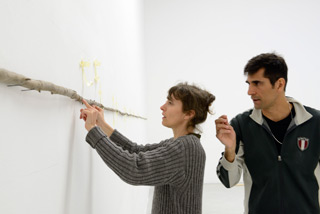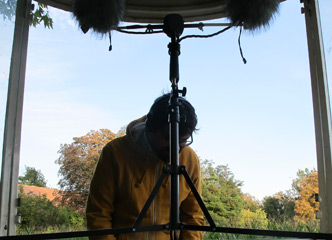Matter as Experience
Through a combination of field trips and fieldwork, the mentors set out to share with participants some first hand experiences of aesthetic encounters with materials and landscape, experimenting a non-hyerarchical ontology where animated and inanimated, organic and inorganic are on the same level. Here, the classic dualisms of form/material, organic/inorganic, man/animal etc., loosen up, leaving room for movements of material aggregation, differentiation and individuation within an all-encompassing cycle in which essence is the life of the matter, through its own cycles and relationships.
From this angle, what really matters are passion for, knowledge of and care towards matter – intended in its morfogenetic becoming – and the relationships between all the different elements originated by matter itself in a specific context. Thus, mankind is only one of the many possible manifestations of matter, a portion of all interrelated life forms. Such vision certainly leads to a radical rediscussion of the antropocentric paradigm.
Throughout the 20th Century, several philosophers, physicists, biologists and antropologists – amongst others – have brought forward models based on the essential relationship between materials and forces, rather than matter and form. Not only objects or organisms have a form: landscape does as well, as much as cities, social structures, and even thoughts. Studies on complexity have shown how fundamental formal aspects are to systems, relationship configurations, to the organisation and “functioning” of reality.
How are things shaped? Which are the constituting principles governing their development? Which the relationships between forms and their contexts? What is the artists’ role and responsibility in shaping things? The module Matter as Experience proposes a series of immersive and shared experiences and individual actions reflecting upon processes of growth, erosion and trasformation of matter at different levels, and upon the interactions between these processes and human beings, in their subjective, social and political dimensions.
SCHEDULE
October 26th
morning
Guided tour to Cittadellarte, including the Pistoletto, Arte Povera collections and temporary exhibitions (curated by Luca Furlan)
afternoon
Presentation of the participants: motivations, expectations
Each participant and the mentors will introduce her/himself through a short story on her/his own life experience
Workshop presentation and introduction to the main topics of the workshop: Perception of environment/Form as an emergent property vs. Hylomorphic model/Epigenetic Landscape (C. H. Waddington)/Vitality of matter/Art as quality of experience
Group discussion
October 27th
Mineral Matter, Relationship with mineral, Landscape, Perception of the environment morning
Field trip and fieldwork:
Serra di Ivrea (Andrate), Piedmont
Monti Pelati Natural Reserve (Baldissero Canavese), Piedmont
afternoon
Brosso Mines (Val Chiusella), Piedmont
Cittadellarte, group discussion
October 28th
Pebbles and riverscapes
morning
Field trip and fieldwork:
Lame del Sesia Park - Sesia’s riverbanks
afternoon
Workshop session, guest: Attila Faravelli
October 29th
Vegetable Matter, Gathering instinct, Means of nourishment
morning
Field trip in the neighbourhood of Cittadellarte, gathering wild plants (edible and medicinal)
afternoon
Workshop session:
Collective experimentations from the projects Epiderma and Esculenta
October 30th
morning
Workshop session: individual and group elaboration on the materials collected and the experience matured in the previous days
“All art is environmental art”, group discussion.
afternoon
Final discussion and public presentation of the works/ documents produced during the workshop sessions
evening
Party
REFERENCES
Jane Bennett, Vibrant Matter: A Political Ecology of Things, Duke University Press Books, 2014
Matthew Calarco, Zoographies: The Question of the Animal from Heidegger to Derrida, Columbia University Press, 2008
Roger Caillois, Writing of Stones, University of Press Virginia, 1985 (translation of L´Ecriture des pierres, Genève, Editions Albert Skira, 1970)
Roger Caillois, Pierres et autres textes, Paris, Gallimard, 1970
Daniel Chamovitz, What a Plant Knows. A Field Guide to the senses, New York, published by Scientific American/Farrar, Straus & Giroux, 2012
John Dewey, Art as experience, Perigee, New York, 1934
Giuseppe Di Napoli, I principi della forma, Giulio Einaudi Editore, 2011
James J. Gibson. The ecological approach to visual perception, Houghton Mifflin, 1979
Tim Ingold, The perception of environment: Essays on Livelihood, Dwelling and Skill, Routledge, 2000
Tim Ingold, Making. Anthropology, Archaeology, Art and Architecture, Routledge, 2013
Sanford Kwinter, A Discourse on Method in “Explorations in Architecture”, ed. Reto Geiser (Basel: Birkhäuser, 2008), 46
Edgar Morin, The Method: Towards a study of humankind. The Nature of Nature, Vol. 1, Princeton University Press, 1977 (translation of La méthode 1. La Nature de la Nature, Seuil, 1977)
Edgar Morin, The Method: Towards a study of humankind, The Life of Life, Vol. 2, Princeton University Press, 1980 (translation of La méthode 2. La Vie de la Vie, Seuil, 1980)
Timothy Morton, Ecology Without Nature: Rethinking Environmental Aesthetics, Harvard University Press, 2009
Timothy Morton, The Ecological Thought, Harvard University Press, 2012
Alfonso Ottobre, Arte, Esperienza e Natura. Il pensiero estetico di John Dewey, Albo Versorio, Milano, 2012
Richard Sennett, The Craftsman, Yale University Press, 2008
Video list:
Michelangelo Frammartino: The four times (2010) and Trees (2013)
Werner Herzog: Desert Apocalypse (1992)

BIOGRAPHY AND STATEMENT
Andrea Caretto (Turin, Italy, 1970) and Raffaella Spagna (Rivoli, Italy, 1967) explore the profound relationships linking human beings to the environment. They conceive art as inquiry, a tool to investigate the multiple dimensions of reality: formal, qualitative and physical quantitative aspects of matter but also philosophical and social ones. In keeping with their educational backgrounds – Landscape Architecture for Spagna, Natural Sciences and Scientific Museology for Caretto – their projects generate complex installations that simultaneously present the study, demonstration and experimentation of their relationship with nature. They investigate the links between human beings and other organisms and inorganic matter, developing long-term projects.
They have been working together on a regular basis since 2002, exhibiting in public and private institutions in Italy and abroad. They are among the founders of the artist collective “Diogene” (www.progettodiogene.eu) and collaborate with the research Center IRIS (Interdisciplinary Research Institute on Sustainability) of the University of Turin and Brescia. They live and work in Cambiano (Turin, Italy).
www.esculenta.org
Among the institutions with which they have collaborated: AIR Krems and kunstraumarcade, Austria, FieldWorks_Wachau (2015); Domaine de Chamarande, France, Vivre/s (2014); Merz Foundation, Turin and Riso Museum, Palermo, Italy, Meteorite in giardino (2014); GAM-Civic Gallery of Modern and Contemporary Art, Turin, Italy, Collezione Sistemica (2012); Khoj International Artists Associations, New Delhi, India, “In Context, food edition I”, Delhi Hand Cart (2012); Mudam, Musée d’Art Moderne Grand-Duc Jean, Luxembourg, Sketches of Space (2010); Marino Marini Museum, Florence, Italy, Azioni 2000-2006 (2006); MART Museum, Rovereto, Italy, Eurasia, Geographic Cross-overs in Art (2008); PAV-Living Art Park, Turin, Italy, Sic Vos non Vobis, Internaturalità, Village Green, Ecosoft Art, Living Material (2014, 2013, 2009, 2008, 2007); CAIRN-Centre d’Art Informel de Recherchesur la Nature, Digne-les-Bains, France, 1Arbre_Populus nigra; De La Transformation Des Choses (2011, 2008); Centre d’Art Le Parvis, Ibos, France, Matières Premières (2007); Obra Social Caja Madrid, Spain, Los Limites del Crecimiento (2007); T1 Turin Triennal, Castello di Rivoli Contemporary Art Museum, The Pantagruel Syndrom, (2005); Villa Croce Contemporary Art Museum, Genova, Italy, Empowerment (2004); Sandretto Re Rebaudengo Foundation, Turin, Italy, Exit and How Latitudes Become Forms (2002; 2003).

GUEST
Attila Faravelli lives and works in Milano (Italy). In his practice he explores the relationship between sound, space and body. His solo music is released by Die Schachtel and Senufo Editions, in duo w/Andrew Belfi (Tumble) he released on Die Schachtel, on Boring Machines with Nicola Ratti and on Presto!? with the artist Nicola Martini. Together with Enrico Malatesta and Nicola Ratti he is founder of the trio ~Tilde. He presented his work in Europe, USA, Cina and South Korea. In 2010 he participated to the 12th International Biennial of Architecture in Venice. Since 2011 he curates The Lift Series of experimental music concerts. In 2012 he was chosen as the Italian curator for the Sounds of Europe project. He is founder and curator for the Aural Tools project, a series of simple objects to document the material and conceptual processes of specific musicians’ sound production practice. Aural Tools are acoustic devices for relating sound to space, the listener, and the body in ways unavailable through traditional recorded media such as CDs or LPs.
www.auraltools.com
http://attilafaravelli.tumblr.com/
download the full documentation about the module and the mentor in PDF format
